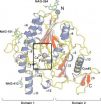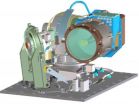(Press-News.org) Sanfilippo A syndrome or Mucopolysaccharidosis IIIA (MPS-IIIA) is a rare genetic lysosomal storage disease inherited from the parents of the patient. Lysosomes are the body's vehicle for breaking down many of its by-products such as proteins, nucleic acids, carbohydrates, lipids and cellular debris. The spherical vesicles are known to contain 50 different enzymes which are all active around an acidic environment of about pH 5.
Whilst each lysosomal disorder results from different gene mutations that translate into a deficiency in enzyme activity, they all share a common biochemical characteristic, which is when the enzyme sulfamidase is present in too small an amount or is missing completely in the cell. When this occurs, substances usually broken down by the cell as unwanted matter accumulate in the cell, leading to severe problems.
Affected children of the disease show developmental delay, behavioural abnormalities such as hyperactivity, and signs of neurodegeneration such as progressive loss of cognitive and motor functions, cerebral convulsions and spastic quadriplegia.
About 80% of the genetic alterations in sulfamidase represent replacement of single amino acids that result in functional inactive enzyme mutants. However the molecular understanding of the effects of these mutations has been confined by a lack of structural data for this enzyme.
A group of scientists from Germany and Spain [Sidhu et al, Acta Cryst. (2014), D70, 1321-1335 doi:10.1107/S1399004714002739] have been successful in resolving the crystal structure of sulfamidase which provides convincing evidence for the molecular consequences of these amino acid replacements and is fundamental for the development of successful structure-based drug design for this devastating neurodegenerative disorder.
Key features for the successful development of novel therapeutic molecules comprise their specific activity to increase residual enzymatic activity of sulfamidase mutants and their ability to pass the blood brain barrier.
The knowledge of the structural features of sulfamidase will greatly facilitate the discovery of suitable compounds and drugs to assist in managing the disease and its debilitating effects.
INFORMATION: END
Scientists provide insight into the pathology of Sanfilippo A syndrome
2014-05-22
ELSE PRESS RELEASES FROM THIS DATE:
Marriage of convenience with a fungus
2014-05-22
This news release is available in German. Thanks to a fungus, the medicinal plant ribwort plantain gains a higher concentration of the defensive compound catalpol. Biologists at Bielefeld University report this discovery in a study to be published this Thursday (22.5.2014) in the scientific journal 'Nature Communications'. The increase in catalpol gives the plant better protection against pests. In the study, the research team worked with arbuscular mycorrhizal fungi. These are known to colonize the roots of land plants. The plants benefit from this, because the fungus ...
Stem-cell research: A new genetic switching element
2014-05-22
Slight modifications in their genome sequences play a crucial role in the conversion of pluripotent stem cells into various differentiated cell types. A team at Ludwig-Maximilians-Universitaet (LMU) in Munich has now identified the factor responsible for one class of modification.
Every cell contains stored hereditary information, encoded in the sequence of nucleobases that make up its DNA. However, in any given cell type, only a fraction of this information is actually used. Which genes are activated and which are turned off is in part determined by a second tier of ...
Low-carb vegan diet may reduce heart disease risk and weight
2014-05-22
TORONTO, May 22, 2014 -- Researchers at St. Michael's Hospital have shown for the first time that, in addition to weight loss, a specific low-carbohydrate diet may also reduce the risk of heart disease by 10 per cent over 10 years.
The diet, often called Eco-Atkins, is a low-carbohydrate vegan diet. Many low-carbohydrate diets have been proven to improve weight loss but most emphasize eating animal proteins and fats, which may raise cholesterol. Diets that are high in vegetable proteins and oils may reduce the risk of heart disease by lowering "bad cholesterol."
"We ...
Medical students may benefit from social media guidance
2014-05-22
Medical students use social media extensively, but medical schools may need to offer more guidance in potential pitfalls, according to Penn State College of Medicine researchers.
"We assessed how medical students engage with social media platforms like Facebook and found that they have a pretty sophisticated understanding of its risks and benefits," said Daniel R. George, assistant professor of humanities. He and Dr. Michael J. Green, professor of humanities, conducted two studies that report findings from a survey of 2,109 medical students nationwide.
In the first ...
Screening for autism: There's an app for that
2014-05-22
DURHAM, N.C. -- Most schools across the United States provide simple vision tests to their students--not to prescribe glasses, but to identify potential problems and recommend a trip to the optometrist. Researchers are now on the cusp of providing the same kind of service for autism.
Researchers at Duke University have developed software that tracks and records infants' activity during videotaped autism screening tests. Their results show that the program is as good at spotting behavioral markers of autism as experts giving the test themselves, and better than non-expert ...
How the gut feeling shapes fear
2014-05-22
An unlit, deserted car park at night, footsteps in the gloom. The heart beats faster and the stomach ties itself in knots. We often feel threatening situations in our stomachs. While the brain has long been viewed as the centre of all emotions, researchers are increasingly trying to get to the bottom of this proverbial gut instinct.
It is not only the brain that controls processes in our abdominal cavity; our stomach also sends signals back to the brain. At the heart of this dialogue between the brain and abdomen is the vagus nerve, which transmits signals in both directions ...
Radiofrequency ablation and complete endoscopic resection equally effective for dysplastic Barrett's esophagus
2014-05-22
DOWNERS GROVE, Ill. – May 21, 2014 – According to a new systematic review article, radiofrequency ablation and complete endoscopic resection are equally effective in the short-term treatment of dysplastic Barrett's esophagus, but adverse event rates are higher with complete endoscopic resection. The article comparing the two treatments appears in the May issue of GIE: Gastrointestinal Endoscopy, the monthly peer-reviewed scientific journal of the American Society for Gastrointestinal Endoscopy (ASGE).
Barrett's esophagus is a condition in which the lining of the esophagus ...
Molecule acts as umpire to make tough life-or-death calls
2014-05-22
(MEMPHIS, Tenn. – May 20, 2014) Researchers have demonstrated that an enzyme required for animal survival after birth functions like an umpire, making the tough calls required for a balanced response to signals that determine if cells live or die. St. Jude Children's Research Hospital scientists led the study, which was published online and appears in the May 22 edition of the scientific journal Cell.
The work involved the enzyme receptor-interacting protein kinase 1 (RIPK1). While RIPK1 is known to be involved in many vital cell processes, this study shows that its pivotal ...
Aggressive behavior observed after alcohol-related priming
2014-05-22
May 22, 2014-- Researchers from California State University, Long Beach, the University of Kent and the University of Missouri collaborated on a study to test whether briefly exposing participants to alcohol-related terms increases aggressive behavior. It has been well documented by previous research that the consumption of alcohol is directly linked to an increase in aggression and other behavioral extremes. But can simply seeing alcohol-related words have a similar effect on aggressive behavior?
Designing the experiment
The study, published in the journal Personality ...
First broadband wireless connection ... to the moon?!
2014-05-22
WASHINGTON, May 22, 2014—If future generations were to live and work on the moon or on a distant asteroid, they would probably want a broadband connection to communicate with home bases back on Earth. They may even want to watch their favorite Earth-based TV show. That may now be possible thanks to a team of researchers from the Massachusetts Institute of Technology's (MIT) Lincoln Laboratory who, working with NASA last fall, demonstrated for the first time that a data communication technology exists that can provide space dwellers with the connectivity we all enjoy here ...



